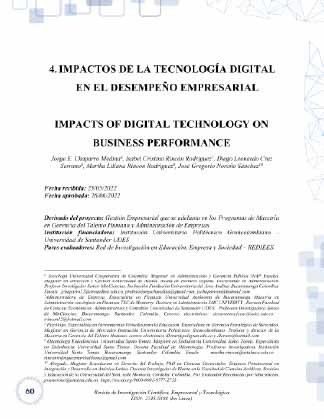IV. IMPACTOS DE LA TECNOLOGÍA DIGITAL EN EL DESEMPEÑO EMPRESARIAL
##plugins.themes.bootstrap3.article.main##
Resumen
El presente artículo nace del proyecto de Gestión Empresarial que se adelanta en los
Programas de Maestría en Gerencia del Talento Humano y Administración de Empresas
(Instituciones de Educación Superior) donde están vinculados los autores. El Objetivo se
orienta a establecer como la transformación digital y la innovación no solo están cambiando
las expectativas y los comportamientos de los consumidores, sino que además está ejerciendo
presión sobre las empresas tradicionales y alterando numerosos mercados.
Metodológicamente, la investigación que se lleva a cabo mediante la exploración analítica
descriptiva permite concluir como las organizaciones empresariales en el contexto actual de
la economía de mercado con el uso de la tecnología digital han generado cambios en el
comportamiento organizacional y en los trabajadores. Por una parte, para las organizaciones
el uso de big data, redes sociales, algoritmos informáticos, inteligencia artificial y robótica
son soluciones para impulsar el negocio y estar a la vanguardia de las necesidades de los
clientes, que cada vez son más exigentes y requieren soluciones inmediatas. Sin embargo, la
tecnología por sí sola no es una solución que defina el éxito, se requiere que el
comportamiento de sus trabajadores esté acorde a estos cambios. Se requiere de la adaptación
rápida del recurso humano a los cambios en la gestión, el pensamiento y el liderazgo.
Download Statistics
##plugins.themes.bootstrap3.article.details##
Gestión Empresarial, Inteligencia artificial, Organizaciones, Herramientas tecnológicas y Ventajas competitivas.
organizational agility: part 2 February 2017Industrial and Commercial Training 49(2):69-74.
DOI: 10.1108/ICT-05-2016-0028
Beer P., Mulder R. H.(2020). The Effects of Technological Developments on Work
and Their Implications for Continuous Vocational Education and Training: A Systematic
Review . Journal Frontiers in Psychology. Vol 11, Art 918.
Caselli, F., Manning, A. (2019), Aritmética de robots: nuevas tecnologías y salarios.
American Economic Review: Perspectives 1 (1), p.1-12
Dwoskin, E. (2015). En Uber, el algoritmo es más controlador que el verdadero jefe,
WTODOS ST. J. B.
Francis, J. & Scheers, C., (2013): The future workplace of young Europeans,
European view, (12/2), págs. 199-204.
Foerster-Metz, EE. UU., Marquardt, K., Golowko, N., Kompalla, A. y Hell, C.
(2018). Digital transformation and its implications on organizational behavior. EU Business
Research Magazine, 2018 (S 3). Article ID 340873, DOI: 10.5171/2018.340873.
Furr N. and Shipilov, A. “Building the Right Ecosystem for Innovation,” MIT Sloan
Management Review 59, no. 4 (summer 2018): 59-64
Gasparovich E.O., Uskova E.V., Dongauzer E.V. (2021) The Impact of Digitalization
on Employee Engagement. In: Ashmarina S.I., Mantulenko V.V. (eds) Digital Economy and
the New Labor Market: Jobs, Competences and Innovative HR Technologies. IPM 2020.
Lecture Notes in Networks and Systems, vol 161. Springer, Cham.
https://doi.org/10.1007/978-3-030-60926-9_20
Gow, K. y McDonald, P., (2006): Attributes required of graduates for the future
workplace. Journal of vocational education and training, 52, 373–396
Gjalt de Jong (2017). Successful strategy and alliances. Thesis University of
groningen ISBN: 978-90-367-8992-9
Kallas, P. (2017), Top 15 más populares sitios de redes sociales (¡y 10 aplicaciones!).
8 de mayo, recuperado dehttps: // www. dreamgrow.com/top-15-mostpopularsocialnetworking-sites/
Khanagha, S., Ansari, S., Parputis, S. Oviedo, L. (2020). Mutualism and the dynamics
of new plataform creation: a study of Cisco and fog computing. Strat. Manag.
J.https://doi.org./10.1002/smj.3147.
Ionescu, L. y Andronie, M. (2019). The future of Jobs in the digital world. At the
ICESBA International Conference, Bucharest (págs. 15-16).
Irani, L. & Six Silberman, (2013). Turkopticon: disruption of worker invisibility in
Amazon Mechanical Turk, sigchi conference pagroceedings in human factors in computing
systems, AIM, Pages 611–620https://doi.org/10.1145/2470654.2470742.
John M. Amis, Brian D. Janz. (2020), Leading Change in Response to COVID-19.
The Journal of Applied Behavioral Science. Volume 56 Issue 3, pp. 272–278
K.N. Lemon, P.C. Verhoef. Understanding customer experience throughout the
customer journey. Journal of Marketing, 80 (6) (2016), pp. 69-96
Kane, G., Palmer, D. Phillips N, David Kiron, And Natasha Buckley., (2019).
Accelerating digital innovation inside and out: Agile teams, ecosystems, and ethics , MIT
Sloan Management Review and Deloitte Insights, View in Article.
Morrison-Smith, S., Ruiz, J. Challenges and barriers in virtual teams: a literature
review. SN Appl. Sci. 2, 1096 (2020).
Nadkarni, S., Prügl, R. Digital transformation: a review, synthesis and opportunities
for future research. Management Review Quarterly. 71, 233–341 (2021).
https://doi.org/10.1007/s11301-020-00185-7
Nemkova E., Demirel P., Baines L. (2019) In search of meaningful work on digital
freelancing platforms: the case of design professionals. New Technology, Work and
Employment. Volume34, Issue3, Pages 226-243
Schallmo, D, Williams, L. Boardman. Digital Transformation of business models —
Best practice, enablers, and roadmap International Journal of Innovation Management, 21 (8)
(2017), p. 1740014
Ted Saarikko, Ulrika H. Westergren, Tomas Blomquist (2020). Digital
transformation: Five recommendations forthe digitally conscious firm. Business Horizons,
Volume 63, Issue 6, November–December, Pages 825-839
Rinne, U. y Zimmermann, K.F., (2016): Die [Consultado el 28 de noviembre de
2021]. Digital working world of today and tomorrow, From politics and contemporary
history, (66 / 18-19).
Stone, k. (2004). From Widgets to Digits: Employment Regulation for the Changing
Workplace. Cambridge.67-77
Sattler, A., (2016): Leadership 4.0.[pdf] available at:
Schildt, H., (2017): Big data y diseño organizacional: el nuevo mundo valiente de la
gestión algorítmica y la transparencia aumentada por computadora, Innovación: organización
y gestión, (19/1), págs. 23-30
Verhoef P.C; Broekhuizen Y.; Bart Y.; Bhattacharyaa A.; Donga J. Qi; Fabiana N.;
Haenleinc M.(2021). Digital transformation: A multidisciplinary reflection and research
agenda. Journal of Business Research Volume 122, January 2021, Pages 889-901
WEF.(2018).The Future of Jobs Report, Available at
Wieczner Jen and M. D. Z., (2020) “Meet the one-branch bank that did more PPP
lending than Citi ,” Fortune , July 15,.
Yogesh K. Dwivedi; Elvira Ismagilova; D. Laurie Hughes; Jamie Carlson; Raffaele
Filieri. (2021). Setting the future of digital and social media marketing research: Perspectives





